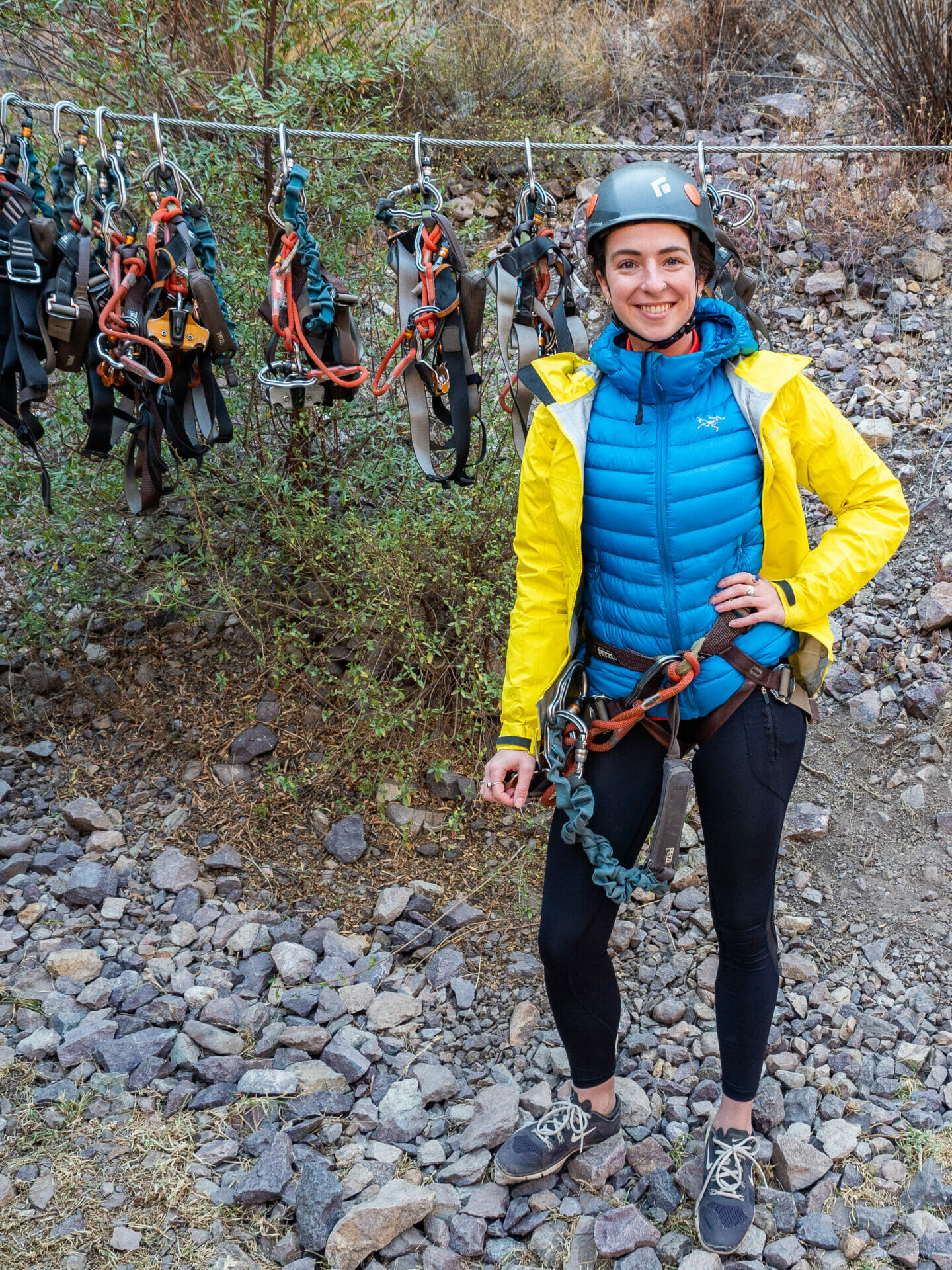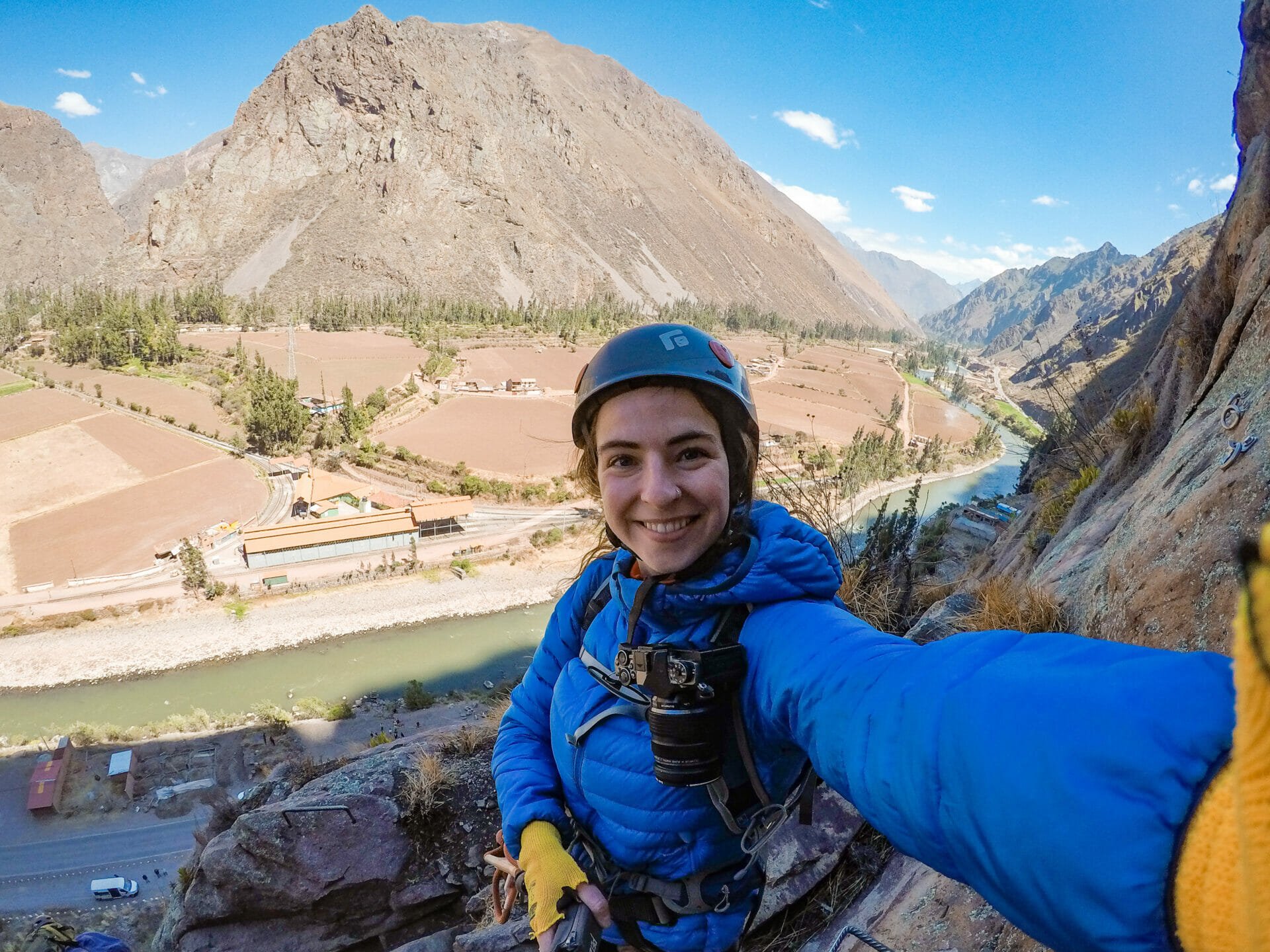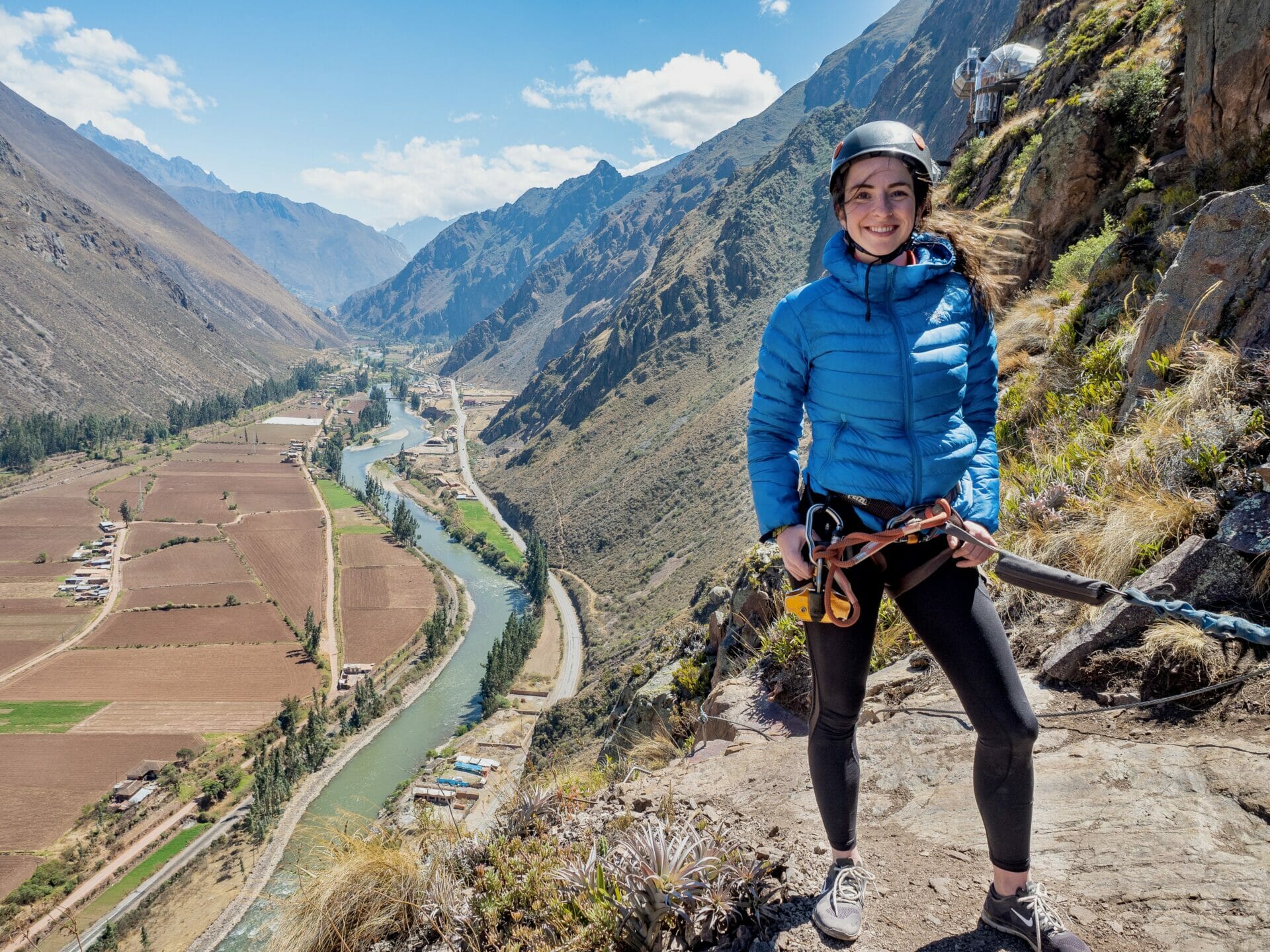
Via ferrata climbing & ziplining in the Sacred Valley: an adrenaline-filled day trip from Cusco
Last Updated on 8 March 2025
About 90 minutes north of Cusco in the shadow of the Peruvian Andes, the lush Urubamba Valley once formed the heart of the Incan empire and was an important agricultural area supplying food for the surrounding regions. Now, this approximately 100km-long valley is home to some of Peru’s most impressive ruins outside of Machu Picchu and is considered an essential day trip for visitors to Cusco.
Thousands flock to archaeological sites and historic towns like Moray and Ollantaytambo each day (as I did last time I was in Cusco), but this time I was seeking a totally different kind of adventure— climbing high over the Sacred Valley for an incredible condor’s view of the stunning landscape before soaring down to the valley floor on a series of exhilarating zip lines. I recently joined the Natura Vive and SkyLodge team for a thrilling day in the mountains, and I left thoroughly convinced that this is the single most exciting way to experience the Sacred Valley.
All the details: Via ferrata & ziplining in the Sacred Valley
Cost | Natura Vive operates via ferrata (climbing) and ziplining tours for S/275, including transport from your hostel in Cusco or the Sacred Valley. For those with a smaller budget or less time, it’s also possible to join a via ferrata only tour or a ziplining only tour (each S/180), while those looking to splurge on the afternoon can include lunch in the SkyLodge with their via ferrata and zipline for a whopping S/880.
Getting there | Natura Vive guides will pick you up from your hostel in the morning and transport you out to the Sacred Valley in a comfortable van, which takes approximately 90min. It’s also possible to be picked up in Cusco and dropped off in the Sacred Valley, absorbing travel time into the tour for those who are planning to stay in Ollantaytambo or surrounds during their trip!
Where to stay | My absolute favourite hostel in Cusco is Kokopelli, which is slightly more expensive than other dorm rooms, but worth every sol. They offer pod-style dorm beds (S/50) that make it feel like you’re in a private room, a great free breakfast (or free packed lunch if you’re departing on an early morning tour), on-site tour booking, and a lively bar and restaurant with surprisingly reasonable prices.
Top tips | Pack a small day bag for your trip out to the Sacred Valley, and be sure to include a water bottle, warm jacket, and camera. I’d also recommend wearing tights or hiking pants and flexible running shoes for your climb.
Read more | THE ULTIMATE CUSCO TRAVEL GUIDE: 25 AMAZING THINGS TO DO IN CUSCO, PERU
A big thank you to Natura Viva for inviting me on their awesome via ferrata and ziplining tour in exchange for an honest review of the experience. As always, all opinions in this post are entirely my own!

After enjoying breakfast and a hot coca tea at Kokopelli, I head down to the reception of my hostel promptly at 8am— only to find out that the guide had arrived early and been looking everywhere for me (obviously with no luck). Rather sheepishly, I follow him out onto the streets of Cusco to wait for the van, which is just picking up a few other travellers across town before looping back around for us. Within the span of a single block, I manage to trip over twice on slippery steps and surprise curbs, so it’s unlikely that anyone has high expectations for my climbing abilities.
Once in the van, along with several guides and 6 other travellers, we hit the road for the 90min drive into the Sacred Valley. The scenery along the way is absolutely breathtaking, a patchwork of green pastures, yellow grass, thick forests, and herds of llama and sheep that travel like an undulating white cloud across various farms.
After each bend in the road, different snow-capped peaks come into view, looming behind the brown, rippled hills that surround Cusco. Short of sticking my entire head out the window (which I do briefly consider), it’s not really possible to get a good picture, but I try to take some mental snapshots of the drive anyway.


Before long, we arrive at the Natura Vive base camp, where the guides make quick work of kitting us out in a harness, helmet, and gloves, followed by a demonstration of the safety procedures for our climbing expedition.
In addition to my van from Cusco, another load of people have arrived from hotels in the Sacred Valley— many of the other travellers will be hiking up to the ziplines and some are following in a larger climbing group, but I relish the opportunity to scramble up the mountain in a tiny group of 4. Joined only by a French couple and their deeply unenthused son, our guide Brian even lets me lead the way up the rock (definitely adding some dangerous fire to all of my Free Solo fantasies).








Although I do have some experience climbing on real rock and in a gym, this is my first time doing true via ferrata (not counting the small section at the end of the TMB). It should actually be excellent practice for my planned Alta Via 2 in the Dolomites next year, which will involve heaps of via ferrata with absolutely no guide supervision (stay tuned for that adventure!).
For those who don’t already know, via ferrata literally translates to “iron way” and is essentially assisted rock climbing— metal rungs and anchors are drilled directly into the side of a mountain, providing climbers with a continuous line of steel cable to clip to and steps/handles to aid in the upwards journey.
Aside from the occasional need to find a hand or foot hold in the rock yourself, ascending a mountain via ferrata is far less physically demanding or technically challenging than true rock climbing. As one of the guides later describes it to me, the owner of Natura Vive wanted to bring the thrill and sensation of rock climbing to those without significant mountaineering experience— I’d say he certainly succeeded.

It was a similar desire, to allow novice climbers the experience of sleeping directly on the side of a mountain without having to use a port-a-ledge, that prompted the creation of the SkyLodge several years later. These incredible aluminium pods are nested right into the vertical face of the rock, providing guests with uninterrupted aerial views of the Sacred Valley and what I can only imagine to be mind-boggling star gazing directly from bed. The construction was intensive and the installation onto the side of the mountain even more so (I later met a mountaineering guide along the Huayhuash Circuit who was involved in the project and could personally attest to this), but the owner was undeterred by skepticism from the local community, many of whom simply couldn’t fathom why people would pay hundreds of dollars to sleep on a mountain.
Fast forward several years and the Skylodge is now fully booked for the next 6 months, more pods are being installed farther down the valley, and plans are even underway for similar accommodation that will float on a nearby lake. Clearly, people are all too ready to spend hundreds of dollars to sleep on a mountain. Had it not been fully booked, I would have happily dipped into my savings for the experience!




For the next hour, our little group blazes up the face of the mountain, constantly re-clipping to the next section of cable and taking every opportunity to snap photos of the expansive Sacred Valley below. Perhaps the highlight of the afternoon is when Brian asks if I climbed this route last time I was in Cusco because I seem to know all of the tricks. I will let myself believe that this isn’t something he says to all of the guests and that it’s actually my climber’s intuition finally bursting forth.
Our group is the first to reach the lunch spot, a wide, rocky ledge with a spectacular view. We were given snack boxes back at base camp, so I take the opportunity to wolf down a cheese sandwich, some dried fruit, and a tangy mandarin before resuming my frenzied photo-taking of the valley and the ruins of Ollantaytambo in the distance.
From here, our climbing transitions into more of a climbing/hiking mix until we finally reach the first zip line. I can already tell these ziplines are far superior to others I’ve been on, the cables stretching so far into distance that they completely disappear.
Sure enough, the ziplines deliver— over the course of 6 lines, I fly across the Sacred Valley and reach (seemingly) rocket speeds before seeing the signal to brake from the other end. At every line, a guide sends and receives you, but otherwise you can almost imagine you’re entirely alone as you move through the air.




All day I’ve been sporting a cheek-splitting grin, delighted by every step of the journey up the mountain and every whizzing metre on the way back down. This has been one of the most unique experiences and undoubtedly one of the best tours I’ve ever participated in.
Natura Vive strikes the perfect balance between safety and adrenaline, and I loved the freedom to climb and zip line without being constantly tethered to a guide or marching in a huge queue of other people. The guides themselves were also fantastic, learning my name immediately and always offering to take photos for me while I was on the rock. I spend the entire ride back to my hostel excitedly reliving the day’s adventure and quizzing the staff about SkyLodge— it seems I’ll just have to come back to Cusco again.

Read more about what to do in Cusco
THE ULTIMATE CUSCO TRAVEL GUIDE: 25 AMAZING THINGS TO DO IN CUSCO, PERU
ABSOLUTELY EVERYTHING YOU NEED TO KNOW ABOUT VISITING MACHU PICCHU (& NEW 2019 REGULATIONS)
HIKING TO MACHU PICCHU: COMPARING THE CLASSIC INCA TRAIL VS SALKANTAY TREK
A GUIDE TO TREKKING AUSANGATE & RAINBOW MOUNTAIN IN PERU
DIY INCA RUINS WALKING TOUR: VISITING TAMBOMACHAY, PUKA PUKARA, Q’ENQO & SACSAHUAMÁN WITHOUT A GUIDE
A PRACTICAL GUIDE TO ALTITUDE SICKNESS IN SOUTH AMERICA
TRAVELLING WITH PERU HOP VS PUBLIC BUSES: AN HONEST COMPARISON
PACIFIC COAST PERU: 2-3 WEEK PERU TRAVEL ITINERARY FROM LIMA TO CUSCO
INCAS & THE AMAZON: 2-3 WEEK PERU TRAVEL ITINERARY FROM LIMA TO MANU NATIONAL PARK
BEST OF THE PERUVIAN ANDES: 3-4 WEEK PERU TREKKING ITINERARY
